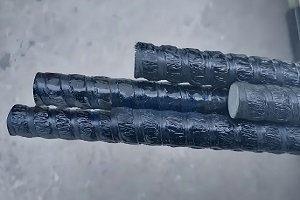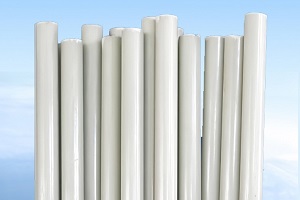- Home
- Fiberglass Tubes
Custom Fiberglass Tubes | Round & Square Tube
GangLong Fiberglass Tubes are just the ticket for applications that need to balance strength-to-weight and cost or need radio transparency.
Fiberglass Tubes are advanced composite materials renowned for their impressive strength, durability, and lightweight properties.Commonly used as tent poles,Fiberglass is non-conductive, has a high strength-to-weight ratio, and performs well in acidic and corrosive environments. Fiberglass Tubes, available in round and square shapes, are widely used for building equipment stands, tool racks, and support structures.
GangLong Fiberglass is a leading supplier, producing millions of feet of fiberglass tubes annually for various industries, including marine, aeronautical, agriculture, and construction. Made from woven glass fibers and resin, these products, along with fiber glass duct board, offer exceptional resistance to corrosion and are ideal for harsh environments. Their versatility, ease of handling, and reliable performance in extreme conditions make Fiberglass Tubes a preferred choice across industrial and commercial applications.
News
- Exploring the Benefits of Carbon Fiber Apparel
- How to Work with Carbon Fiber Successfully
- Carbon Fiber Suit: The Future of Lightweight Armor
- Is Carbon Fiber Armor the Future of Protection?
- Why White Carbon Fiber is Popular in Automotive Design
- Transparent Carbon Fiber Sheets: Strength Meets Clarity in Design
- Chopped Carbon Fiber Mat for Lightweight Reinforcement
- Carbon Fiber EG Hatch: Upgrade Your Civic Today
- The Benefits of Using Structural Carbon Fibre in Engineering
- How Many Layers of Layered Carbon Fiber Are Needed?
Simplifying Your Life: Key Functionalities

| Attribute | Details |
|---|---|
| Place of Origin | Hebei, China (some from Beijing, China) |
| Brand Name | GangLong Fiberglass |
| Material | Fiberglass Reinforced Plastic (FRP), Unsaturated polyester, Epoxy Glass Fabric Laminated Tube |
| Applications | Tent poles, agricultural support poles, electrical equipment, high voltage, industry, and agriculture |
| Techniques | Pultrusion, molding, rolled, and molded processes |
| Surface Treatment | Smooth, UV-resistant, machine-processed |
| Processing Services | Sharpening, drilling, painting, cutting, bending, decoiling, moulding, welding, punching |
| Colors | Customized colors available |
| Shapes | Round tubes, square tubes, section bars |
| Density | 1.7-2.1 g/cm³ |
| Fiberglass Content | 65%-70% |
| Features | Flexible, anti-corrosion, anti-aging, abrasion-resistant, waterproof, heat-insulating, high strength, dielectric properties, anti-corrosion, high mechanical property |
| Certifications | ISO |
| Standards | IEC, NEMA |
| Product Types | FRP poles, hollow rods, rectangular/round tubes, epoxy fiberglass tubes, laminated tubes |
| Supply Ability | 50 Tons per Month |
| OEM Services | Acceptable |
Thank you for your interest in our products. To receive our pricelist or for any inquiries, please fill out the form below. We will get back to you within 24 hours.
Fiberglass Tubes Standard Dimensions
Fiberglass tubes are composite materials made from glass fibers embedded in a resin matrix, providing a high strength-to-weight ratio and resistance to corrosion and environmental factors. Ideal for various applications due to their non-conductive properties and durability.
Common Dimensions
Diameter:
Standard Sizes: Fiberglass tubes are available in various diameters, commonly ranging from 1 inch to 12 inches.
- Small Diameter: 1″, 1.5″, 2″
- Medium Diameter: 3″, 4″, 5″, 6″
- Large Diameter: 8″, 10″, 12″
Tolerance: Typically, the diameter tolerances can be ±0.05 inches depending on manufacturing processes.
Wall Thickness:
The wall thickness is crucial for determining the strength and flexibility of the tube.
Standard Wall Thicknesses:
- Light Duty: 0.062″ (1/16″)
- Medium Duty: 0.125″ (1/8″)
- Heavy Duty: 0.187″ (3/16″), 0.250″ (1/4″)
Customization: Custom wall thicknesses can be specified based on load requirements and application needs.
Length:
Standard lengths are often available in:
- 10 Feet: Common for shipping and handling.
- 12 Feet: Often used in structural applications.
- Custom Lengths: Available upon request, with lengths exceeding 20 feet possible based on manufacturer capabilities.
- Cutting Services: Many suppliers offer cutting services to achieve specific lengths for projects.
Strength and Load Capacity
- Flexural Strength: Fiberglass tubes exhibit high flexural strength, often measured in psi (pounds per square inch). Typical values range from 40,000 to 70,000 psi, depending on the tube’s design and manufacturing process.
- Load Capacity: Determined by:
- Diameter and wall thickness.
- Length of the span and type of load (axial, lateral, etc.).
- Testing Standards: Load testing may conform to standards like ASTM D198 or similar.
Customization
Many manufacturers provide options for custom sizes and configurations to suit specific applications, including:
- Color and Finish: Gel-coated or painted finishes for aesthetic and protective purposes.
- Reinforcement Options: Additional layers or materials for enhanced strength or specific performance characteristics.
Standards and Compliance
Compliance with industry standards ensures quality and safety:
- ASTM Standards: For material properties and testing methods.
- ISO Certifications: For manufacturing practices and quality control.
Fiberglass tubes are highly versatile components available in a range of standard dimensions, accommodating various applications across multiple industries. Understanding the specifications regarding diameter, wall thickness, and length is essential for selecting the appropriate tube for your project requirements. Custom options and adherence to industry standards further enhance their usability and reliability.
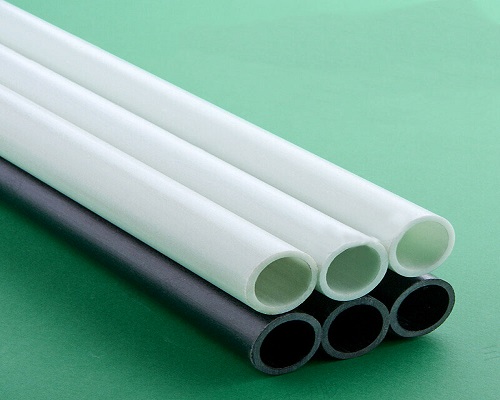
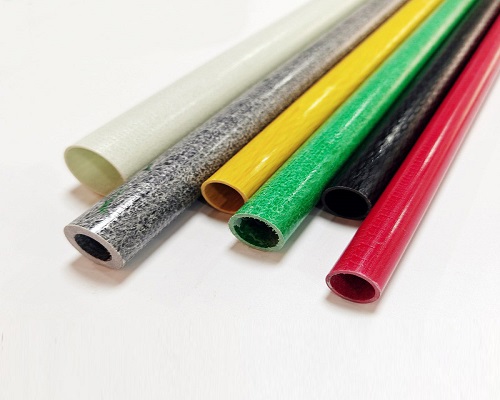
Fiberglass Tubes Design Features
1. Material Composition
- Glass Fiber Reinforcement: Composed of woven glass fibers that provide strength and rigidity.
- Resin Matrix: Typically made from epoxy, polyester, or vinyl ester resins that bond the fibers and protect against environmental factors.
2. Lightweight Construction
Fiberglass tubes are significantly lighter than metal counterparts, facilitating easier handling and installation without compromising strength.
3. Corrosion Resistance
Resistant to a wide range of chemicals, moisture, and environmental conditions, making them suitable for use in corrosive environments (e.g., marine applications, chemical processing).
4. Structural Integrity
- High Strength-to-Weight Ratio: Provides excellent load-bearing capacity while minimizing overall weight.
- Flexural and Tensile Strength: Capable of withstanding bending and pulling forces without deformation or failure.
5. Customizable Dimensions
Available in a variety of diameters, wall thicknesses, and lengths, allowing for tailored solutions to meet specific project requirements.
Options for custom shapes, such as square or rectangular tubes, in addition to standard round tubes.
6. Thermal Insulation
Fiberglass tubes have low thermal conductivity, making them suitable for applications where temperature control is important.
7. Non-Conductive Properties
Excellent electrical insulation properties, making them ideal for use in electrical and electronic applications.
8. Aesthetic Options
Available in various colors and finishes, including gel-coated surfaces for added durability and visual appeal.
Custom printing or labeling options for branding or identification.
9. Ease of Fabrication
Fiberglass tubes can be easily cut, shaped, or joined with various techniques, including adhesives, mechanical fittings, or welding, depending on the application.
10. Impact Resistance
Designed to absorb shocks and impacts without cracking or breaking, contributing to their durability in demanding environments.
11. UV Resistance
Many fiberglass tubes are treated to resist degradation from UV exposure, enhancing longevity in outdoor applications.
12. Compliance with Standards
Designed to meet industry-specific standards for safety, quality, and performance, ensuring reliability in critical applications.
The design features of fiberglass tubes make them a versatile choice for a variety of industries. Their lightweight, corrosion-resistant, and customizable characteristics, combined with their structural integrity and aesthetic options, enable them to effectively meet diverse application needs while ensuring durability and performance.
Fiberglass Tubes Round and Square Tube
Fiberglass tubes are hollow cylindrical or rectangular structures made from reinforced plastic using glass fibers. They are known for their high strength-to-weight ratio, corrosion resistance, and versatility, making them suitable for various applications in industries such as construction, automotive, aerospace, and marine.
Round Fiberglass Tubes
Shape and Dimensions:
- Round fiberglass tubes are cylindrical in shape, characterized by a uniform diameter throughout their length.
- They are available in various diameters and wall thicknesses, which can be customized depending on the application.
Properties:
- Strength: High tensile strength and rigidity, making them resistant to bending and breaking.
- Corrosion Resistance: Excellent resistance to chemical and environmental factors, making them ideal for outdoor and marine applications.
- Lightweight: Significantly lighter than metal tubes, facilitating easier handling and installation.
Applications:
- Used in piping systems for transporting liquids and gases.
- Commonly found in electrical applications as conduit for wiring.
- Utilized in the construction of structural components, such as poles and supports.
Square Fiberglass Tubes
Shape and Dimensions:
- Square fiberglass tubes have a square cross-section, providing a different aesthetic and functional profile compared to round tubes.
- Like round tubes, they come in various sizes and wall thicknesses, allowing for a range of applications.
Properties:
- Structural Integrity: The square shape allows for easy stacking and alignment, providing enhanced structural stability.
- Corrosion Resistance: Similar to round tubes, square tubes resist corrosion and weathering.
- Versatility: Can be used in both load-bearing and decorative applications.
Applications:
- Frequently used in furniture design, including frames and supports.
- Employed in manufacturing racks, shelves, and other storage solutions.
- Often used in architectural applications, providing aesthetic and structural support.
Both round and square fiberglass tubes offer unique advantages, with their choice largely depending on the specific requirements of the project. Their lightweight, corrosion-resistant properties, and strength make them a popular choice in a wide array of applications. Whether you need cylindrical shapes for fluid transport or square shapes for structural support, fiberglass tubes provide an effective solution.
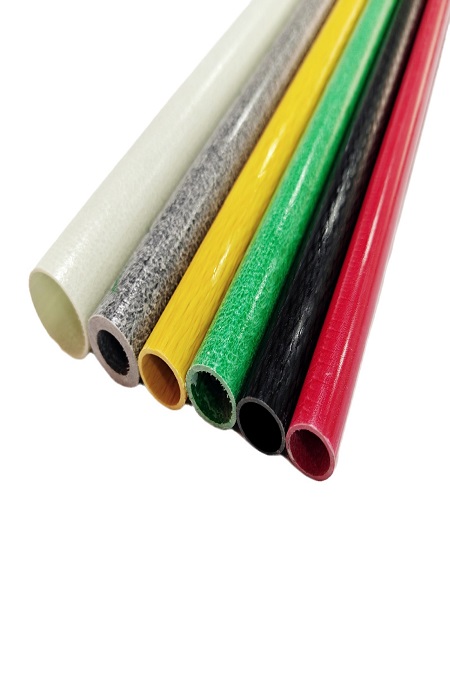
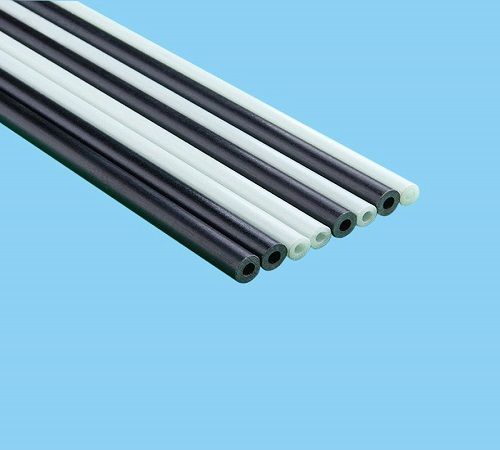
Pultruded Fiberglass Tubes
Pultruded fiberglass tubes are created through a manufacturing process called pultrusion, where fiberglass fibers are drawn through a resin bath and then cured in a heated die to form continuous lengths of tube. This method results in strong, lightweight structures with uniform cross-sections.
Manufacturing Process
- Pultrusion Process: Pultruded fiberglass tubes are created by pulling fiberglass fibers through a resin bath and then curing them in a heated die. This method ensures uniform density, eliminating air bubbles and enhancing strength.
- Continuity: The process allows for the production of continuous lengths of material, making it suitable for projects requiring large quantities.
Material Properties
- Strength: Pultruded fiberglass tubes exhibit excellent tensile and compressive strength, making them capable of bearing heavy loads.
- Lightweight: Compared to metal tubes, pultruded tubes are significantly lighter, which reduces transportation and installation costs.
- Corrosion Resistance: With their exceptional chemical resistance, pultruded tubes perform well in moist or corrosive environments, ideal for marine and chemical applications.
Applications
- Construction Industry: Used as structural supports, beams, and railings, particularly where corrosion resistance and lightweight characteristics are essential.
- Electrical Industry: Function as conduits for electrical wiring, protecting cables from environmental factors.
- Automotive and Aerospace: Employed in manufacturing lightweight body components and structural parts, reducing overall weight and improving fuel efficiency.
- Sports Equipment: Utilized in producing bicycle frames, sporting goods, and other gear, balancing strength with weight.
Economic Benefits
- Cost-Effectiveness: While initial investment may be higher than traditional materials, their durability and low maintenance costs lead to savings over time.
- Recyclability: Many pultruded fiberglass tubes can be recycled at the end of their lifecycle, aligning with sustainable development goals.
Design Flexibility
- Customization Options: Pultruded tubes can be tailored to specific needs, including various diameters, wall thicknesses, and colors.
- Aesthetic Appeal: Beyond functionality, pultruded tubes can be designed for aesthetic applications, making them suitable for furniture and decorative uses.
Pultruded fiberglass tubes, with their unique manufacturing process, superior material properties, and diverse applications, represent an important choice in modern industry. Whether in construction, electrical, transportation, or sporting goods, they offer ideal solutions that combine strength, lightweight characteristics, and resistance to environmental challenges.
Types of Fiberglass Tubes
Standard Fiberglass Tubes
Characteristics: Standard Fiberglass Tubes are known for their lightweight nature, high strength, and excellent corrosion resistance. Made from a composite of glass fibers and resin, these tubes offer superior durability while remaining easy to handle and install. Their resistance to environmental factors, such as moisture and chemicals, ensures they maintain their structural integrity over time.
Common Uses: These tubes are versatile and used in a variety of applications. They are commonly employed as structural supports in construction projects, as well as in the fabrication of antennas and equipment stands. Their robust properties make them ideal for applications where strength and reliability are crucial.
Fiberglass Square Tubing
Overview: Fiberglass Square Tubing is distinguished by its square cross-section, which provides increased stability and load-bearing capacity compared to round tubes. This type of tubing is fabricated using the same composite materials as standard fiberglass tubes, offering similar advantages in terms of strength and corrosion resistance.
Applications: Square fiberglass tubing is widely used for structural reinforcement and framework in various industries. Its shape makes it particularly useful in applications requiring precise alignment and support, such as in scaffolding, building frameworks, and equipment supports. The added rigidity of fiberglass square tube enhances its suitability for structural applications, where stability and durability are paramount.
Product Range and Specifications
Diameters and Lengths
Standard Sizes: The range of Fiberglass Tubes available typically includes diameters from as small as 0.25 inches to as large as 12 inches. For specific applications, large diameter fiberglass tubes are also available to cater to heavy-duty needs. Lengths of these tubes vary widely, often ranging from a few feet to over 8 feet, depending on the intended use and shipping considerations. These standard sizes cover a broad spectrum of applications, from lightweight structural supports to more substantial engineering projects.
Customization: If the standard diameters and lengths do not meet your particular requirements, custom options are available. Many suppliers offer bespoke services to produce fiberglass tubes tailored to specific dimensions and performance criteria. Customization options can include varying diameters, wall thicknesses, and lengths to match the unique needs of a project, ensuring that the fiberglass tubes are optimized for the intended application.
Price Range and Availability
Fiberglass Tubes Price: The cost of Fiberglass Tubes varies based on factors such as diameter, length, and the type of fiberglass used. Prices generally range from around $10 to $200 or more per tube. Larger diameter tubes and those with special requirements or custom specifications tend to be more expensive. Pricing also fluctuates based on market conditions and supplier policies.
Fiberglass Tubes for Sale: GangLong Fiberglass Suppliers sells a wide range of fiberglass tubing. Typical pricing can be found on product pages of GangLong Fiberglass suppliers, where you can compare costs based on size and type. Additionally, bulk purchasing or wholesale options may provide cost savings for larger orders, making it easier to source the necessary quantities for extensive projects.
Applications of Fiberglass Tubes
Industrial Uses
Examples: Fiberglass Tubes are widely used in various industrial sectors due to their exceptional properties. In the construction industry, they serve as structural supports and reinforcements, especially in areas requiring high strength and low weight. In aerospace, fiberglass tubes are integral in manufacturing lightweight components for aircraft, contributing to overall fuel efficiency and performance. The automotive industry benefits from these tubes for making lightweight yet strong parts, which enhance vehicle performance and safety. Additionally, fiberglass tubes are used in chemical processing and telecommunications for their corrosion resistance and durability.
Advantages: The primary benefits of using Fiberglass Tubes in industrial applications include their high strength-to-weight ratio, which allows for significant load-bearing capacity without adding excessive weight. Their resistance to environmental factors such as moisture, chemicals, and extreme temperatures makes them ideal for harsh conditions. Furthermore, fiberglass tubes are non-conductive, making them suitable for electrical and electronic applications where insulation is crucial. Their long-term durability and minimal maintenance requirements further contribute to their appeal in demanding industrial environments.
Everyday Applications
Practical Uses: In everyday settings, Fiberglass Tubes are highly versatile and useful for a range of practical applications. They are often employed in household projects, such as creating custom shelving, garden stakes, or lightweight supports for home improvement tasks. For recreational activities, fiberglass tubes are commonly used in making tent poles for camping, fishing rod supports, or even in certain sports equipment. DIY enthusiasts also find these tubes valuable for crafting and building projects due to their ease of handling and adaptability. Their combination of strength and lightweight properties makes them an ideal choice for various personal and recreational uses.
Buying Guide
Considerations for Purchase
Factors to Consider: When buying Fiberglass Tubes, several key factors should be evaluated to ensure you select the right product for your needs. First, consider the diameter and length of the tubes. Fiberglass tubes come in various diameters and lengths, so choosing the right size is crucial depending on your application, whether it’s for structural support, recreational use, or DIY projects. Additionally, think about the intended use of the tubes. Different applications may require specific types of fiberglass tubes with particular properties, such as greater strength or resistance to environmental conditions.
Comparing Options: To make an informed decision, compare different types of Fiberglass Tubes based on their specifications and suitability for your project. For instance, if strength and durability are your main concerns, you might opt for tubes designed for industrial use. Conversely, if you need tubes for lightweight applications, such as camping gear, choose options that are optimized for low weight while still providing adequate strength. Pay attention to factors such as the resin type used, the manufacturing process, and whether custom sizes are available.
GangLong Fiberglass: Your Reliable Partner for Fiberglass Tubing
When selecting a supplier for Fiberglass Tubing, choosing a reliable partner like GangLong Fiberglass is crucial for ensuring high-quality products. Here’s what makes GangLong Fiberglass stand out:
Reputation for Quality: With a strong track record in delivering top-notch Fiberglass Tubes, GangLong Fiberglass is known for its commitment to quality and customer satisfaction.
Comprehensive Product Range: We offer a diverse selection of Fiberglass Tubes to meet various needs, including customization options to fit specific requirements.
Detailed Specifications: GangLong Fiberglass provides thorough product specifications to ensure you receive exactly what you need.
Industry Standards: Our products adhere to strict industry standards, guaranteeing reliability and performance.
Support and Service: We offer valuable technical advice and exceptional after-sales service to assist with product selection and any specific requirements you may have.
Competitive Pricing: Enjoy transparent pricing, bulk purchasing options, and competitive rates with no hidden costs.
Choose GangLong Fiberglass for dependable, high-quality Fiberglass Tubing and comprehensive support tailored to your needs.
Fiberglass Tubes of Safety and Maintenance
Handling Fiberglass Tubes
Safety Precautions: When working with Fiberglass Tubes, it is crucial to follow safety guidelines to avoid health risks. Fiberglass tubes can produce fine dust and small fibers that may cause respiratory issues or skin irritation. Always wear protective gear, such as gloves, masks, and safety glasses, to shield yourself from these particles. Work in well-ventilated areas or use dust extraction systems to minimize airborne fiberglass particles. Additionally, avoid direct contact with the fibers by using tools or methods that reduce the need for manual handling. Proper disposal of any waste materials is also important to prevent environmental contamination.
Maintenance Tips
Care Instructions: To ensure the longevity and performance of your Fiberglass Tubes, follow these maintenance tips. Regularly inspect the tubes for signs of wear, damage, or degradation, such as cracks or delamination. Clean the tubes with a mild detergent and water to remove any dirt or debris that might affect their performance. Avoid using harsh chemicals or abrasive materials that could damage the fiberglass surface. Store the tubes in a dry, cool place away from direct sunlight and extreme temperatures, as excessive heat or moisture can compromise their structural integrity. For applications requiring high performance, periodic professional inspections might be necessary to ensure that the tubes continue to meet required standards.
Custom Fiberglass Tubes – Lightweight, Durable, and Corrosion-Resistant
Engineered for Strength and Performance
Custom pultruded fiberglass composite tubes are made from a proprietary combination of fiberglass reinforcement materials and thermosetting polyester or vinyl ester resin systems. With over 100 standard shapes available, these tubes offer exceptional mechanical properties and are designed for high-performance applications.
Each fiberglass tube is surfaced with a protective veil, preventing fiber exposure, enhancing UV resistance, and increasing corrosion protection for long-lasting durability.
Key Features of Pultruded Fiberglass Tubes
- Corrosion-resistant – Ideal for harsh environments where traditional materials degrade
- Lower lifecycle costs – Long-lasting performance reduces maintenance expenses
- Easy to fabricate and install – Lightweight properties allow for quick assembly
- High strength-to-weight ratio – Stronger than wood and lighter than steel
- Superior impact and flexural strength – Enhances structural integrity
- Dimensional stability – Maintains shape under varying environmental conditions
- Flame retardant – Can be manufactured with fire-resistant properties
- Non-conductive and non-magnetic – Safe for electrical applications
- Resistant to insect damage – Will not be affected by termites or pests
- Low water absorption – Prevents moisture-related degradation
Stronger and Safer Than Traditional Materials
Compared to steel, aluminum, and stainless steel, pultruded fiberglass tubes provide superior tensile strength, durability, and rigidity. Their high impact resistance makes them a preferred alternative for demanding applications where both lightweight properties and structural performance are essential.
Ganglong Fiberglass manufactures fiberglass tubes in round, square, and rectangular profiles, available in various resin systems, glass matrices, and colors to meet project-specific requirements. Our engineering team can assist in designing custom tubular profiles that maximize strength, reduce weight, and lower material costs.
Customizable Pultrusion Process for Tailored Solutions
Our pultrusion manufacturing process allows us to produce fiberglass tubes according to exact specifications, offering greater design flexibility. Compared to traditional materials like steel and aluminum, pultruded composites offer:
- 75 percent weight reduction while maintaining equivalent strength
- Longer service life and reduced maintenance
- A safer alternative with non-conductive and corrosion-resistant properties
Whether you need custom fiberglass tubes for industrial, structural, or commercial applications, Ganglong Fiberglass delivers high-quality, cost-effective, and high-performance solutions.
Contact us today to discuss your custom fiberglass tube requirements and find the best solution for your project.
FAQs about Fiberglass Tubes
What is the strength of a fiberglass tube?
How do you cut a fiberglass tube?
Can You Paint Fiberglass Tubes?
Cleaning: Thoroughly clean the fiberglass surface to remove dirt, grease, and any contaminants.
Sanding: Lightly sand the surface with fine-grit sandpaper to create a rough texture, which helps the paint adhere better.
Priming: Use a primer designed for fiberglass to enhance adhesion and improve the paint's longevity.
Painting: Apply paint suitable for fiberglass, such as marine-grade paint or acrylic paint, in thin, even coats. Make sure to allow adequate drying time between coats.
What Are the Three Types of Fiberglass?
Description: Made from random strands of fiberglass, CSM is bonded together with a resin. It’s commonly used for creating flat surfaces and provides good strength and flexibility.
Applications: Often used in boat building, automotive parts, and general fiberglass applications.
Woven Roving:
Description: Composed of woven fiberglass strands, this type offers greater strength and is less flexible than CSM. It is thicker and provides a higher tensile strength.
Applications: Typically used in applications requiring high strength, such as in the construction of boats, automotive parts, and industrial applications.
Fiberglass Cloth:
Description: Made from tightly woven fiberglass strands, this type provides excellent strength and durability. It can be used with various resins for specific applications.
Applications: Commonly used in high-performance applications like aerospace, automotive, and high-strength structural components.
What are fiberglass tubes used for?
How long do fiberglass mortar tubes last?
What is fiberglass most used for?
Can you reuse fiberglass fireworks tubes?
What are the benefits of fiberglass pipes?
Corrosion Resistance: They are highly resistant to corrosion, making them ideal for transporting corrosive fluids or in corrosive environments.
Lightweight: Fiberglass pipes are much lighter than metal pipes, making them easier to transport and install.
High Strength: Despite their lightweight nature, fiberglass pipes are strong and can withstand significant pressure.
Durability: They have a long lifespan, with excellent resistance to environmental degradation.
Low Maintenance: They require less maintenance compared to metal pipes, reducing long-term operational costs.
Why do people use fiberglass?
Where is fiberglass pipe used?
Who needs fiberglass?
How strong is fiberglass pipe?
How do you cut fiberglass tubing?
Mark the Cut Line: Use a marker or tape to mark the line where you want to cut.
Secure the Tubing: Clamp the tubing securely to prevent it from moving during the cut.
Use the Right Tool: Use a fine-toothed saw or a cutting wheel designed for fiberglass.
Cut Slowly: Apply gentle pressure and cut slowly to avoid splintering or cracking the fiberglass.
Smooth the Edges: After cutting, use sandpaper or a file to smooth the edges to prevent splinters.
What is the best tool to cut fiberglass?
How do you cut fiberglass without cracking it?
Use the Right Blade: Choose a fine-toothed or diamond-grit blade specifically designed for cutting fiberglass.
Secure the Material: Ensure the fiberglass is securely clamped to minimize movement during cutting.
Cut at a Steady Pace: Avoid forcing the tool through the material; instead, cut slowly and steadily to prevent cracking.
Score Before Cutting: For thinner fiberglass, scoring the cut line with a utility knife before cutting can help guide the blade and reduce the risk of cracking.
Cool the Blade: If using a power tool, keep the blade cool by cutting in short bursts or using water to prevent overheating, which can lead to cracking.
How do you cut fiberglass by hand?
Use a Fine-Toothed Saw: A hacksaw with a fine-toothed blade or a handsaw designed for composite materials is suitable.
Mark the Cut Line: Clearly mark the cutting line on the fiberglass.
Secure the Material: Clamp the fiberglass securely to prevent movement.
Saw Gently: Begin sawing gently along the marked line, applying consistent pressure without forcing the blade.
Smooth the Edges: After cutting, use sandpaper or a file to smooth the edges.
What kind of blade to cut fiberglass?
Is it safe to cut up fibreglass?
Wear Protective Gear: Always wear safety goggles, gloves, and a dust mask or respirator to protect against fiberglass dust and particles.
Work in a Well-Ventilated Area: Ensure good ventilation to avoid inhaling fiberglass dust.
Avoid Skin Contact: Cover exposed skin to prevent irritation from fiberglass particles.
Clean Up Thoroughly: After cutting, clean up the area carefully to remove any fiberglass dust.
Can luse a circular saw to cut fiberglass?
Can you cut fiberglass rebar with a hacksaw?
Should you wear a mask when cutting fiberglass?
How strong is fiberglass tubing?
How hard is fiberglass to break?
What is the strongest type of tubing?
Is fiberglass stronger than steel?
What weakens fiberglass?
UV Exposure: Prolonged exposure to sunlight can degrade the resin, leading to brittleness and weakening of the fiberglass structure.
Moisture Ingress: Water penetration can cause delamination or swelling of the resin matrix, reducing the strength of the composite.
Chemical Exposure: Certain chemicals can degrade the resin, leading to reduced structural integrity.
Physical Damage: Cracks, cuts, or impacts can introduce weaknesses that may propagate over time.
Excessive Heat: While fiberglass is heat resistant, excessive temperatures can soften or degrade the resin.
What is the strongest type of fiberglass?
How much weight can Fibreglass hold?
How long does fiberglass pipe last?
Is Fibreglass stronger than PVC?
Is fiberglass stronger than plastic?
Can fiberglass withstand pressure?
What is fiberglass tubing used for?
Structural supports: In construction, electrical, and marine industries.
Protective sleeves: For cables and wires.
Sports equipment: Like tent poles, kite frames, and archery bows.
Industrial components: In chemical processing and water treatment plants.
Aerospace and automotive: For lightweight and durable structural components.
What is fiberglass conduit used for?
What are the disadvantages of fiberglass conduit?
Cost: Fiberglass conduit is more expensive than other types of conduit like PVC or metal.
Brittleness: It can be more brittle than PVC, especially in colder temperatures, which may lead to cracking if not handled properly.
Limited Impact Resistance: Although strong, fiberglass conduit can crack or splinter under severe impact.
Special Handling: Requires specialized tools for cutting and installation.
Is fiberglass conduit cheaper than PVC?
Why use fiberglass pipe?
How do you cut fiberglass conduit?
Mark the Cut Line: Clearly mark where you need to cut.
Secure the Conduit: Clamp the conduit firmly to prevent it from moving during the cut.
Use the Right Tool: Use a fine-toothed saw, such as a hacksaw or a power tool with a diamond-grit blade, to make the cut.
Cut Slowly: Apply steady pressure and cut slowly to avoid splintering or cracking the fiberglass.
Smooth the Edges: Use sandpaper or a file to smooth the cut edges and remove any sharp fibers.
Is PVC the same as fiberglass?
Which is stronger, pVC or conduit?
Is fiberglass conduit fire rated?
What is the NEC code for fiberglass conduit?
What are the uses of fiberglass tubing?
Electrical Insulation: As conduit for wires and cables, especially in corrosive or high-temperature environments.
Structural Supports: In construction, as lightweight, corrosion-resistant beams and frames.
Marine Applications: For masts, booms, and other structural components in boats.
Aerospace: In lightweight, strong components for aircraft.
Recreational Equipment: For poles, tent frames, and sports gear.
What is fiberglass wire used for?
Do you need conduit for fiber?
What is the best conduit to use?
PVC Conduit: Good for general use, especially in residential applications where flexibility and low cost are important.
Fiberglass Conduit: Ideal for industrial environments where corrosion resistance and high strength are needed.
Metal Conduit (EMT, RMC): Suitable for areas where high impact resistance and fire protection are important.
Flexible Conduit: Useful in situations where the conduit needs to bend around obstacles or in tight spaces.

